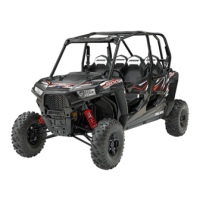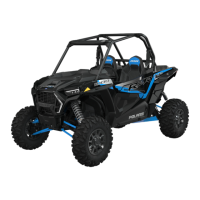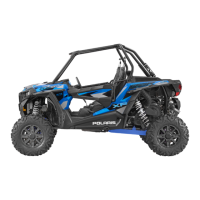8.19
ELECTRICAL
8
6. Inspect the permanent magnets in starter housing. Make
sure they are not cracked or separated from housing.
Starter Reassembly
1. Place armature in field magnet casing.
2. Inspect and replace the O-rings if damaged.
3. Install case sealing O-ring. Make sure O-ring is in good
condition and not twisted on the case. Lubricate the ends
of the armature shaft and oil seal with a light film of grease,
and install housing.
4. Install brush housing onto the armature, pushing back
brushes while installing armature shaft.
5. Reinstall starter motor housing screws and washers. Make
sure O-rings are in good condition and seated in groove.
Tighten sufficiently.
6. Reinstall the starter motor to the engine.
Voltage Drop Test
The Voltage Drop Test is used to test for bad connections. When
performing the test, you are testing the amount of voltage drop
through the connection. A poor or corroded connection will
appear as a high voltage reading.
To perform the test, place the meter on DC volts and place the
meter leads across the connection to be tested. Refer to the chart
on next page to perform voltage drop tests on the starter system.
Starter System Troubleshooting
Starter Motor Does Not Turn
• Battery discharged - low specific gravity
• Loose or faulty battery cables or corroded connections
(see Voltage Drop Tests)
• Related wiring loose, disconnected, or corroded
• Poor ground connections at battery cable, starter motor
or starter solenoid (see Voltage Drop Tests)
• Faulty starter button
• Faulty ignition switch (Do other systems function?)
• Faulty starter solenoid or starter motor
• Engine problem - seized or binding (Can engine be
rotated easily with recoil starter?).
Starter Motor Turns Over Slowly
• Battery discharged - low specific gravity
• Excessive circuit resistance - poor connections (see
Voltage Drop Test below)
• Engine problem - seized or binding (Can engine be
rotated easily with recoil starter?)
• Faulty or worn brushes in starter motor
• Automatic compression release inoperative
Starter Motor Turns - Engine Does Not Rotate
• Faulty starter drive
• Faulty starter drive gears or starter motor gear
• Faulty flywheel gear or loose flywheel
Use care when handling the starter housing.
Do not drop or strike the housing, as magnet
damage is possible. If the magnets are damaged,
the starter must be replaced.
Voltage should not exceed
.1 DC volts per connection
PartShark.com
877-999-5686

